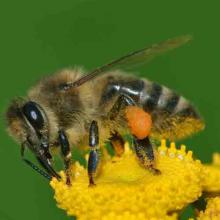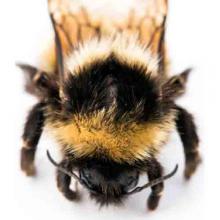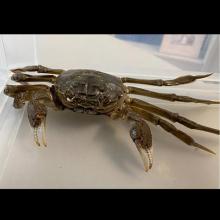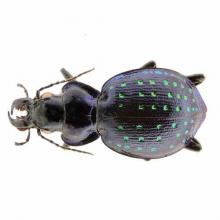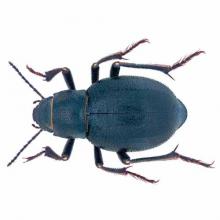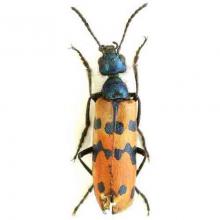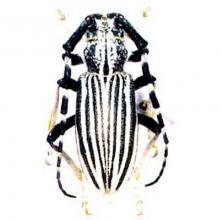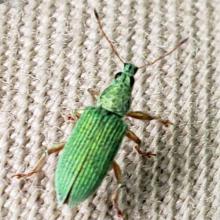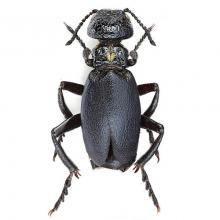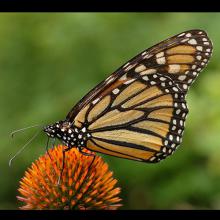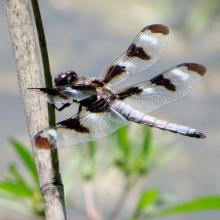Apis mellifera
Common name:
Western honey bee
Class:
Insecta
Subphylum:
Hexapoda
Phylum:
Arthropoda
Argiope trifasciata
Common name:
Banded garden spider
Class:
Arachnida
Subphylum:
Chelicerata
Phylum:
Arthropoda
Orthemis ferruginea
Common name:
Roseate skimmer
Class:
Insecta
Subphylum:
Hexapoda
Phylum:
Arthropoda
Deilephila elpenor
Common name:
Elephant hawk-moth
Class:
Insecta
Subphylum:
Hexapoda
Phylum:
Arthropoda
Gasteracantha cancriformis
Common name:
Spinybacked spider
Class:
Arachnida
Subphylum:
Chelicerata
Phylum:
Arthropoda
Bombus polaris
Common name:
Arctic bumblebee
Class:
Insecta
Subphylum:
Hexapoda
Phylum:
Arthropoda
Calopteryx maculata
Common name:
Ebony jewelwing
Class:
Insecta
Subphylum:
Hexapoda
Phylum:
Arthropoda
Eriocheir sinensis
Common name:
Chinese mitten crab
Class:
Malacostraca
Subphylum:
Crustacea
Phylum:
Arthropoda
Panulirus argus
Common name:
Caribbean spiny lobster
Class:
Malacostraca
Subphylum:
Crustacea
Phylum:
Arthropoda
Calosoma fischeri
Common name:
Fischer's caterpillar hunter
Class:
Insecta
Subphylum:
Hexapoda
Phylum:
Arthropoda
Sternoplax zichyi
Common name:
Darkling beetle
Class:
Insecta
Subphylum:
Hexapoda
Phylum:
Arthropoda
Mylabris mongolica
Common name:
Northern blisterbeetle
Class:
Insecta
Subphylum:
Hexapoda
Phylum:
Arthropoda
Eodorcadion gorbunovi
Common name:
Longhorn beetle
Class:
Insecta
Subphylum:
Hexapoda
Phylum:
Arthropoda
Rhaebus komarovi
Common name:
Weevil
Class:
Insecta
Subphylum:
Hexapoda
Phylum:
Arthropoda
Meloe centripubens
Common name:
Blister beetle
Class:
Insecta
Subphylum:
Hexapoda
Phylum:
Arthropoda
Endoxyla cinereus
Common name:
Giant wood moth
Class:
Insecta
Subphylum:
Phylum:
Arthropoda
Papilio glaucus
Common name:
Eastern tiger swallowtail
Class:
Insecta
Subphylum:
Hexapoda
Phylum:
Arthropoda
Danaus plexippus
Common name:
Monarch butterfly
Class:
Insecta
Subphylum:
Hexapoda
Phylum:
Arthropoda
Neotibicen tibicen
Common name:
Swamp cicada
Class:
Insecta
Subphylum:
Hexapoda
Phylum:
Arthropoda
Libellula pulchella
Common name:
Twelve-spotted skimmer
Class:
Insecta
Subphylum:
Hexapoda
Phylum:
Arthropoda
Apis mellifera
Common name:
Western honey bee
Class:
Insecta
Subphylum:
Hexapoda
Phylum:
Arthropoda
Argiope trifasciata
Common name:
Banded garden spider
Class:
Arachnida
Subphylum:
Chelicerata
Phylum:
Arthropoda
Orthemis ferruginea
Common name:
Roseate skimmer
Class:
Insecta
Subphylum:
Hexapoda
Phylum:
Arthropoda
Deilephila elpenor
Common name:
Elephant hawk-moth
Class:
Insecta
Subphylum:
Hexapoda
Phylum:
Arthropoda
Gasteracantha cancriformis
Common name:
Spinybacked spider
Class:
Arachnida
Subphylum:
Chelicerata
Phylum:
Arthropoda
Bombus polaris
Common name:
Arctic bumblebee
Class:
Insecta
Subphylum:
Hexapoda
Phylum:
Arthropoda
Calopteryx maculata
Common name:
Ebony jewelwing
Class:
Insecta
Subphylum:
Hexapoda
Phylum:
Arthropoda
Eriocheir sinensis
Common name:
Chinese mitten crab
Class:
Malacostraca
Subphylum:
Crustacea
Phylum:
Arthropoda
Panulirus argus
Common name:
Caribbean spiny lobster
Class:
Malacostraca
Subphylum:
Crustacea
Phylum:
Arthropoda
Calosoma fischeri
Common name:
Fischer's caterpillar hunter
Class:
Insecta
Subphylum:
Hexapoda
Phylum:
Arthropoda
Sternoplax zichyi
Common name:
Darkling beetle
Class:
Insecta
Subphylum:
Hexapoda
Phylum:
Arthropoda
Mylabris mongolica
Common name:
Northern blisterbeetle
Class:
Insecta
Subphylum:
Hexapoda
Phylum:
Arthropoda
Eodorcadion gorbunovi
Common name:
Longhorn beetle
Class:
Insecta
Subphylum:
Hexapoda
Phylum:
Arthropoda
Rhaebus komarovi
Common name:
Weevil
Class:
Insecta
Subphylum:
Hexapoda
Phylum:
Arthropoda
Meloe centripubens
Common name:
Blister beetle
Class:
Insecta
Subphylum:
Hexapoda
Phylum:
Arthropoda
Endoxyla cinereus
Common name:
Giant wood moth
Class:
Insecta
Subphylum:
Phylum:
Arthropoda
Papilio glaucus
Common name:
Eastern tiger swallowtail
Class:
Insecta
Subphylum:
Hexapoda
Phylum:
Arthropoda
Danaus plexippus
Common name:
Monarch butterfly
Class:
Insecta
Subphylum:
Hexapoda
Phylum:
Arthropoda
Neotibicen tibicen
Common name:
Swamp cicada
Class:
Insecta
Subphylum:
Hexapoda
Phylum:
Arthropoda
Libellula pulchella
Common name:
Twelve-spotted skimmer
Class:
Insecta
Subphylum:
Hexapoda
Phylum:
Arthropoda
Apis mellifera
Common name:
Western honey bee
Class:
Insecta
Subphylum:
Hexapoda
Phylum:
Arthropoda
Argiope trifasciata
Common name:
Banded garden spider
Class:
Arachnida
Subphylum:
Chelicerata
Phylum:
Arthropoda
Orthemis ferruginea
Common name:
Roseate skimmer
Class:
Insecta
Subphylum:
Hexapoda
Phylum:
Arthropoda
Deilephila elpenor
Common name:
Elephant hawk-moth
Class:
Insecta
Subphylum:
Hexapoda
Phylum:
Arthropoda
Gasteracantha cancriformis
Common name:
Spinybacked spider
Class:
Arachnida
Subphylum:
Chelicerata
Phylum:
Arthropoda
Bombus polaris
Common name:
Arctic bumblebee
Class:
Insecta
Subphylum:
Hexapoda
Phylum:
Arthropoda
Calopteryx maculata
Common name:
Ebony jewelwing
Class:
Insecta
Subphylum:
Hexapoda
Phylum:
Arthropoda
Eriocheir sinensis
Common name:
Chinese mitten crab
Class:
Malacostraca
Subphylum:
Crustacea
Phylum:
Arthropoda
Panulirus argus
Common name:
Caribbean spiny lobster
Class:
Malacostraca
Subphylum:
Crustacea
Phylum:
Arthropoda
Calosoma fischeri
Common name:
Fischer's caterpillar hunter
Class:
Insecta
Subphylum:
Hexapoda
Phylum:
Arthropoda
Sternoplax zichyi
Common name:
Darkling beetle
Class:
Insecta
Subphylum:
Hexapoda
Phylum:
Arthropoda
Mylabris mongolica
Common name:
Northern blisterbeetle
Class:
Insecta
Subphylum:
Hexapoda
Phylum:
Arthropoda
Eodorcadion gorbunovi
Common name:
Longhorn beetle
Class:
Insecta
Subphylum:
Hexapoda
Phylum:
Arthropoda
Rhaebus komarovi
Common name:
Weevil
Class:
Insecta
Subphylum:
Hexapoda
Phylum:
Arthropoda
Meloe centripubens
Common name:
Blister beetle
Class:
Insecta
Subphylum:
Hexapoda
Phylum:
Arthropoda
Endoxyla cinereus
Common name:
Giant wood moth
Class:
Insecta
Subphylum:
Phylum:
Arthropoda
Papilio glaucus
Common name:
Eastern tiger swallowtail
Class:
Insecta
Subphylum:
Hexapoda
Phylum:
Arthropoda
Danaus plexippus
Common name:
Monarch butterfly
Class:
Insecta
Subphylum:
Hexapoda
Phylum:
Arthropoda
Neotibicen tibicen
Common name:
Swamp cicada
Class:
Insecta
Subphylum:
Hexapoda
Phylum:
Arthropoda
Libellula pulchella
Common name:
Twelve-spotted skimmer
Class:
Insecta
Subphylum:
Hexapoda
Phylum:
Arthropoda
Phylum-Animalia: Arthropoda
An arthropod (/ˈɑːrθrəpɒd/, from Greek ἄρθρον arthron, "joint" and πούς pous, "foot" (gen. ποδός)) is an invertebrate animal having an exoskeleton, a segmented body, and paired jointed appendages. Arthropods form the phylum Euarthropoda, which includes insects, arachnids, myriapods, and crustaceans. The term Arthropoda as originally proposed refers to a proposed grouping of Euarthropods and the phylum Onychophora.
Arthropods are characterized by their jointed limbs and cuticle made of chitin, often mineralised with calcium carbonate. The arthropod body plan consists of segments, each with a pair of appendages. The rigid cuticle inhibits growth, so arthropods replace it periodically by moulting. Arthropods are bilaterally symmetrical and their body possesses an external skeleton. Some species have wings.
Their versatility has enabled arthropods to become the most species-rich members of all ecological guilds in most environments. They have over a million described species, making up more than 80 percent of all described living animal species, some of which, unlike most other animals, are very successful in dry environments. Arthropods range in size from the microscopic crustacean Stygotantulus up to the Japanese spider crab.
An arthropod's primary internal cavity is a haemocoel, which accommodates its internal organs, and through which its haemolymph – analogue of blood – circulates; it has an open circulatory system. Like their exteriors, the internal organs of arthropods are generally built of repeated segments. Their nervous system is "ladder-like", with paired ventral nerve cords running through all segments and forming paired ganglia in each segment. Their heads are formed by fusion of varying numbers of segments, and their brains are formed by fusion of the ganglia of these segments and encircle the esophagus. The respiratory and excretory systems of arthropods vary, depending as much on their environment as on the subphylum to which they belong.
Their vision relies on various combinations of compound eyes and pigment-pit ocelli: in most species the ocelli can only detect the direction from which light is coming, and the compound eyes are the main source of information, but the main eyes of spiders are ocelli that can form images and, in a few cases, can swivel to track prey. Arthropods also have a wide range of chemical and mechanical sensors, mostly based on modifications of the many bristles known as setae that project through their cuticles.
Arthropods' methods of reproduction and development are diverse; all terrestrial species use internal fertilization, but this is often by indirect transfer of the sperm via an appendage or the ground, rather than by direct injection. Aquatic species use either internal or external fertilization. Almost all arthropods lay eggs, but scorpions give birth to live young after the eggs have hatched inside the mother. Arthropod hatchlings vary from miniature adults to grubs and caterpillars that lack jointed limbs and eventually undergo a total metamorphosis to produce the adult form. The level of maternal care for hatchlings varies from nonexistent to the prolonged care provided by scorpions.
The evolutionary ancestry of arthropods dates back to the Cambrian period. The group is generally regarded as monophyletic, and many analyses support the placement of arthropods with cycloneuralians (or their constituent clades) in a superphylum Ecdysozoa. Overall, however, the basal relationships of animals are not yet well resolved. Likewise, the relationships between various arthropod groups are still actively debated.
Arthropods contribute to the human food supply both directly as food, and more importantly indirectly as pollinators of crops. Some species are known to spread severe disease to humans, livestock, and crops.
Reference: Wikipedia

